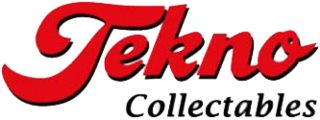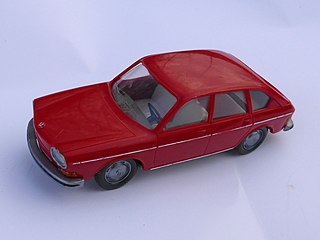
Schuco is a German brand and former manufacturing company founded in 1912 by Heinrich Müller and the businessman Heinrich Schreyer in Nuremberg, popularly known as Germany's toy capital. The company's specialty was making toy reproductions of cars and trucks in tin, plastic and die-cast. The company went bankrupt in 1976 but was reorganized in 1993 and then totally independent again by 1996 before its acquisition by the Simba Dickie Group in 1999.

Opel Blitz was the name given to various light and middleweight trucks built by the German Opel automobile manufacturer between 1930 and 1975. The original logo for this truck, two stripes arranged loosely like a lightning symbol in the form of a horizontally stretched letter "Z", still appears in the current Opel logo. The Blitz name was then applied to the British-made Bedford CF when it replaced the Blitz in certain markets.

Minichamps is a die-cast model car brand founded as Paul's Model Art GmbH in 1990 in Aachen, Germany, best known for its 1:18, 1:43 and 1:64 scale models. The company grew out of the Danhausen trade catalog of miniature vehicles and specially made Danhausen diecast releases during the 1970s.

Bburago is a manufacturing company of toys and die-cast scale model cars formerly based in Italy. The company was based in Burago di Molgora, where all products were made from 1974 to 2005. At the height of its popularity, Bburago's main competitors were Politoys and Maisto, the latter of which was to become dominant in the 1:18 market segment around 2000.

Tekno is a Danish manufacturing company of scale model trucks and other vehicles, currently headquartered in De Lier, Netherlands. Originally established and based in Copenhagen, Tekno began manufacturing construction toys in 1928 and model vehicles immediately after World War II, selling 1 million a year during its peak.

Schabak is a die-cast toy producer based in Nuremberg, Germany. The company is well known for its line of German cars and commercial airline models. The company's on and off relation with German Schuco Modell is particularly notable.

Conrad GmbH is a German manufacturer of diecast scale model trucks, primarily in 1:50 scale for use both as toys and promotional models by heavy equipment manufacturers. Conrad is one of the few European diecast companies which have not outsourced production to China or elsewhere in Asia. Conrad Modelle is headquartered in Kalchreuth, just northeast of Nuremberg.
Nürnberger Zinkdruckguß-Modelle GmbH is a German manufacturer of diecast scale models primarily in 1:50 scale for use both as toys and promotional models mainly by heavy transport and construction equipment manufacturers.

Meccanica Bessana Toys, was an Italian toy manufacturer that produced die-cast scale model cars during the 1960s and 1970s.

Solido is a French manufacturing company which produces die-cast scale models of cars, military vehicles and commercial vehicles. The models are usually made of a zamac alloy in varying scales.

The automotive industry in Germany is one of the largest employers in the world, with a labor force of over 857,336 (2016) working in the industry.

Polistil S.p.A. is an Italian toy brand and former manufacturing company headquartered in Milan, with production center in Chiari, near Brescia. Polistil specialized in die-cast and plastic scale model vehicles of all sizes.

Gama is a German maker of toys, usually cars and trucks, dating from before World War I. The company is headquartered in Fürth, Bavaria, near Nürnberg, a traditional German toymaking center. Other German companies that competed with Gama Toys were Schuco Modell and Conrad Models.

Cursor Modell was a German company making models of antique and modern German vehicles. It is best known for its plastic replicas of vehicles mainly of the era 1880 to about 1920, produced for, and sold in, the Daimler-Benz museum in Stuttgart.
Eligor is a brand of collector's diecast model cars and trucks mostly made in 1:43 scale. Models have always been made in France, but the company has gone through several ownership changes. Today, though now focusing on model trucks, Eligor is one of the few diecast modelers still making its vehicles in Europe.
Winross is a diecast model truck producer based in Churchville, New York, just west of Rochester. The company was started in 1963 to make models of White brand trucks. Winross was the pioneer in 1/64 scale promotional model semi-tractor-trailer trucks. The trucks were known for their wide variety of logos and promotional ads on their sides. Over time trucks have become more sophisticated and the company has moved into silk screen printing for a variety of products.
Holand Oto is a Dutch manufacturing company based in Weert that produces diecast scale model cars and trucks. The company was established in 1959 in Heerlen as "Bestbox", then changing its name to "Efsi" in early 1970s.
Dugu Miniautotoys was a brand of diecast metal models, mostly in 1:43 scale, made in Varallo Sesia, Vercelli Province, Piedmont, Italy, north of Turin and west of Lake Orto. The company made models for the Carlo Biscaretti di Ruffia Automobile Museum in Turin. They were made from approximately 1961–1975, and perhaps a few years longer.
Rétrospectives Automobiles Miniatures was a French manufacturing company that made diecast scale model collector vehicles mostly of classic French automobiles in 1:43 scale. The acronym was seen on packaging without the periods between the letters of the acronym, but on some of the vehicle bases with the punctuation. "J.M.K." was a further acronym that stood for the three founding members of the company: M. Jarry, Henri Malartre and M. Koch. Though the models were often known simply as RAMI, the full name of the company was RAMI by J.M.K.
Société Anonyme de Fabrication d'Injection et de Recherches was a French manufacturing company that produced diecast metal classic veteran and contemporary plastic race cars and other vehicles in the 1960s through the 1970s. It arose out of the previous French toymaker, "Jadali".
















